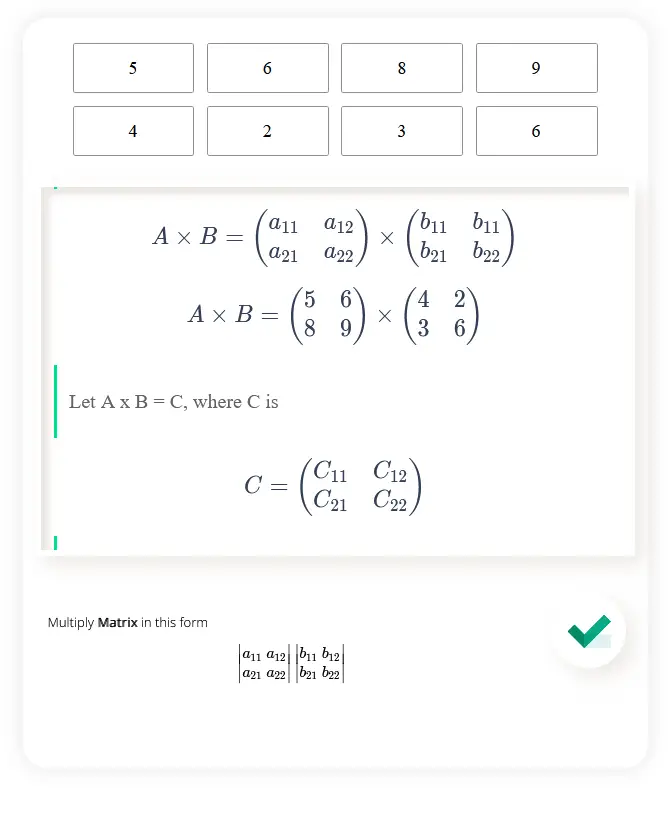Multiply Matrix in this form \[ \begin{vmatrix} a_{11} \ a_{12} \\ a_{21} \ a_{22} \end{vmatrix} \begin{vmatrix} b_{11} \ b_{12} \\ b_{21} \ b_{22} \end{vmatrix} \]

Matrix multiplication is a binary operation that takes two matrices as input and produces a new matrix as output. It involves multiplying the corresponding elements of the rows of the first matrix with the corresponding elements of the columns of the second matrix, and summing up these products to obtain the elements of the resulting matrix. That is what MathCrave matrix multiplication calculator does with clear step by step solution.
The number of columns in the first matrix must be equal to the number of rows in the second matrix for matrix multiplication to be defined. The resulting matrix will have the same number of rows as the first matrix and the same number of columns as the second matrix. Matrix multiplication is a fundamental operation in linear algebra and is used in various fields such as physics, computer science, and engineering.
Matrix multiplication is an operation performed on two matrices to produce a new matrix. It is a fundamental operation in linear algebra and is used in various fields such as computer graphics, physics, and data analysis. Matrix multiplication is defined for matrices of compatible dimensions, where the number of columns in the first matrix must be equal to the number of rows in the second matrix.
The process of matrix multiplication involves multiplying the corresponding elements of each row of the first matrix with the corresponding elements of each column of the second matrix, and then summing up these products to obtain the elements of the resulting matrix. The resulting matrix will have the same number of rows as the first matrix and the same number of columns as the second matrix.
To illustrate the process, let's consider two matrices A and B. Matrix A has dimensions m x n, and matrix B has dimensions n x p. The resulting matrix C will have dimensions m x p. The element at the i-th row and j-th column of matrix C is obtained by multiplying the i-th row of matrix A with the j-th column of matrix B, and summing up the products.
Mathematically, the element c_ij of matrix C is given by:
c_ij = a_i1 b_1j + a_i2 b_2j + ... + a_in * b_nj
where a_ij represents the element at the i-th row and j-th column of matrix A, and b_ij represents the element at the i-th row and j-th column of matrix B.
Matrix multiplication can be computationally intensive, especially for large matrices, as it requires performing a large number of multiplications and additions. However, it is a powerful tool for solving systems of linear equations, transforming vectors and coordinates, and performing various mathematical operations in linear algebra.
Matrix multiplication is widely used in various fields and is an essential concept in linear algebra.
